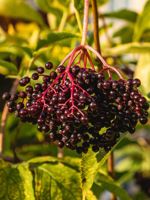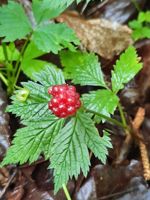Mon-Fri 9am - 5pm Mountain time
Bob Gordon Elderberry vs Dewberry (Dwarf Raspberry)
Sambucus canadensis Bob Gordon
Rubus pubescens
Bob Gordon Elderberry is a Black Elderberry cultivar that produces berries that are larger and sweeter than other varieties, making it one of the top cultivars. It produces large clusters of white flowers that turn into large clusters of dark purple to black berries. The berries are well-suited for baked goods, jams, jellies, and syrups. It was selected from the wild in Missouri.
The large berry clusters that the Bob Gordon Elderberry produces will often end up hanging downward. This makes it more difficult for birds to feed on the berries. If birds are a concern, this might be the right berry for you.
Black Elderberries are considered to be partially self-pollinating. So while they will still produce some berries without cross-pollination, planting with another variety will increase yields. Consider planting with Black Elderberry or Ranch Elderberry.
Warning: the seeds, stems, leaves, roots, and uncooked berries are toxic to humans when eaten in quantity. Berries should be cooked to make them safe for human consumption.
Dewberry (Rubus pubescens) is a native, low-growing perennial that spreads by creeping stems to form a natural groundcover. In spring, it bears small white flowers that attract pollinators, followed by bright red edible berries resembling tiny raspberries. They are an important food source for birds and mammals.
Widespread across Canada, Dewberry serves as a larval host plant for butterflies such as the Spring Azure (Celastrina ladon), adding to its ecological value. It is a suitable choice for naturalization, pollinator gardens, habitat plantings, and ecological restoration projects.
Bob Gordon Elderberry Quick Facts
Dewberry (Dwarf Raspberry) Quick Facts
Toxicity: leaves, stems, and uncooked berries are poisonous to humans

